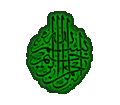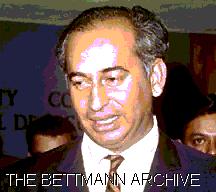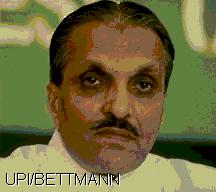
HISTORY OF PAKISTAN

Mohenjo-Daro
RuinsThe ruins of the ancient city Mohenjo-Daro are
found in the province of Sind, southern Pakistan. Dating to 2500 BC,
the ruins are an important source of information about the Indus Valley
civilization, which was one of the world's first great civilizations.
For the early history of the region now known as Pakistan,
see Indus Valley Civilization; India: History.
The British ruled the Indian subcontinent for nearly
200 years—from 1756 to 1947. After the revolt in 1857, the British initiated
political reforms, allowing the formation of political parties. The Indian
National Congress, representing the overwhelming majority of Hindus, was
created in 1885. The Muslim League was formed in 1906 to represent the
Muslim minority. When the British introduced constitutional reforms in
1909, the Muslims demanded and acquired separate electoral rolls. This
guaranteed Muslims representation in the provincial as well as the national
legislatures until independence was granted in 1947.
By 1940, however, the Muslim League had resolved to seek
the partitioning of the subcontinent and the creation of a separate Muslim
state—Pakistan. During preindependence talks in 1946, therefore, the British
government found that the stand of the Muslim League on separation and
that of the Congress on the territorial unity of India were irreconcilable.
The British then decided on partition and on August 15, 1947, transferred
power to both India and Pakistan. The latter, however, came into existence
in two parts: West Pakistan, coextensive with the country's present boundries,
and East Pakistan, now known as Bangladesh. The two were separated by 1600
km (1000 mi) of Indian territory.
Problems of Partition
The division of the subcontinent caused tremendous dislocation
of populations. Some 3.5 million Hindus and Sikhs moved from Pakistan into
India, and about 5 million Muslims migrated from India to Pakistan. The
demographic shift caused an initial bitterness between the two countries
that was further intensified by each country's accession of a portion of
the princely states. Nearly all of these 562 widely scattered polities
joined either India or Pakistan; the princes of Hyderabad, Junagadh, and
Kashmir, however, chose not to join either country.
On August 15, 1947, these three states became technically
independent, but when the Muslim ruler of Junagadh, with its predominantly
Hindu population, joined Pakistan a month later, India annexed his territory.
Hyderabad's Muslim prince, ruling over a mostly Hindu population, tried
to postpone any decision indefinitely, but in September 1948 that issue
was also settled by Indian arms. The Hindu ruler of Kashmir, whose subjects
were 85 percent Muslim, decided to join India. Pakistan, however, questioned
his right to do so, and a war broke out between India and Pakistan. Although
the United Nations (UN) subsequently resolved that a plebiscite be held
under UN auspices to determine the future of Kashmir, India continued to
occupy about two-thirds of the state and refused to hold a plebiscite.
This deadlock, which still persists, has intensified suspicion and antagonism
between the two countries.
Prerepublican Era
The first government of Pakistan was headed by Prime
Minister Liaquat Ali Khan, with Muhammad Ali Jinnah as governor-general,
and it chose Karachi as its capital. From 1947 to 1951 the country functioned
under chaotic conditions. The government endeavored to create a new national
capital, organize the bureaucracy and the armed forces, resettle refugees,
and contend with provincial politicians who often defied its authority.
Failing to offer any program of economic and social reform, however, it
did not gain popular support.
In foreign policy, Liaquat established friendly relations
with the United States when he visited President Harry S. Truman in 1950,
but he overlooked the geographical closeness of the Union of Soviet Socialist
Republics (USSR) to Pakistan and the implications of that fact for the
future security of the country. The visit to the United States injected
bitterness into Soviet-Pakistani relations because Liaquat had previously
accepted an invitation from Moscow that never materialized in a visit.
The United States gave no substantial aid to Pakistan until three years
later.
After Liaquat was assassinated in 1951, Khwaja Nazimuddin,
an East Pakistani who had been governor-general since Jinnah's death in
1948, became prime minister. Unable to prevent the erosion of the Muslim
League's popularity in East Pakistan, however, he was forced to yield to
another East Pakistani, Muhammad Ali Bogra, in 1953. When the Muslim League
was nevertheless routed in East Pakistani elections in 1954, the governor-general
dissolved the constituent assembly as no longer representative. The new
assembly that met in 1955 was not dominated by the Muslim League. Muhammad
Ali Bogra was then replaced by Chaudhri Muhammad Ali, a West Pakistani.
At the same time, General Iskander Mirza became governor-general.
The new constituent assembly enacted a bill, which became
effective in October 1955, integrating the four West Pakistani provinces
into one political and administrative unit. The assembly also produced
a new constitution, which was adopted on March 2, 1956. It declared Pakistan
an Islamic republic. Mirza was elected provisional president.
Cabinet Shifts
The new charter notwithstanding, political instability
continued because no stable majority party emerged in the National Assembly.
Prime Minister Ali remained in office only until September 1956, when he
was succeeded by Huseyn Shaheed Suhrawardy, leader of the Awami League
of East Pakistan. His tenure lasted for slightly more than a year. When
President Mirza discovered that Suhrawardy was planning an alliance between
East and West Pakistani political forces by supporting Firoz Khan Noon,
leader of the Republican party, for the presidency, Mirza forced Suhrawardy
to resign. The succeeding coalition government, headed by Ismail Ibrahim
Chundrigar, lasted only two months before it was replaced by a Republican
party cabinet under Noon. President Mirza, however, found that his influence
among the Republicans was diminishing and that the new prime minister had
come to an understanding with Suhrawardy. Against such a coalition Mirza
had no chance of being reelected president. Dissatisfied with parliamentary
democracy, he proclaimed martial law on October 7, 1958, dismissed Noon's
government, and dissolved the National Assembly.
The president was supported by General Muhammad Ayub
Khan, commander in chief of the armed forces, who was named chief martial-law
administrator. Twenty days later Ayub forced the president to resign and
assumed the presidency himself.
The Ayub Years
Ayub ruled Pakistan almost absolutely for more than ten
years, and his regime made some notable achievements, although it did not
eliminate the basic problems of Pakistani society. A land reforms commission
appointed by Ayub distributed some 900,000 hectares (about 2.2 million
acres) of land among 150,000 tenants. The reforms, however, did not erase
feudal relationships in the countryside; about 6000 landlords still retained
an area three times larger than that given to the 150,000 tenants. Ayub's
regime also increased developmental funds to East Pakistan more than threefold.
This had a noticeable effect on the economy of the eastern part, but the
disparity between the two sectors of Pakistan was not eliminated.
Perhaps the most pervasive of Ayub's changes was his
system of Basic Democracies. It created 80,000 basic democrats, or union
councillors, who were rural influentials or leaders of urban areas around
the country. They constituted the electoral college for presidential elections
and for elections to the national and provincial legislatures created under
the constitution promulgated by Ayub in 1962. The Basic Democratic System
had four tiers of government from the national to the local level, and
each tier was assigned certain responsibilities in administering the rural
and urban areas, such as maintenance of elementary schools, public roads,
and bridges.
Ayub also promulgated an Islamic marriage and family
laws ordinance in 1961, imposing restrictions on polygamy and divorce and
reinforcing the inheritance rights of women and minors.
For a long time Ayub maintained cordial relations with
the United States, stimulating substantial economic and military aid to
Pakistan. This relationship deteriorated, however, in 1965, when another
war with India broke out over Kashmir. The United States then suspended
military and economic aid to both countries, thus denying Pakistan badly
needed weapons. The USSR intervened to mediate the conflict, inviting Ayub
and Prime Minister Lal Bahadur Shastri of India to Toshkent. By the terms
of the so-called Toshkent Agreement of January 1966 the two countries withdrew
their forces to prewar positions and restored diplomatic, economic, and
trade relations. Exchange programs were initiated, and the flow of capital
goods to Pakistan increased greatly.
The Toshkent Agreement and the Kashmir war, however,
generated frustration among the people and resentment against President
Ayub. Foreign Minister Zulfikar Ali Bhutto resigned his position and agitated
against Ayub's dictatorship and the loss of Kashmir. Ayub tried unsuccessfully
to make amends, and in March 1969 he resigned. Instead of transferring
power to the speaker of the National Assembly, as the constitution dictated,
he handed it over to the commander in chief of the army, General Agha Muhammad
Yahya Khan. Yahya assumed the presidential office and declared martial
law.
Civil War
In an attempt to make his martial-law regime more acceptable,
Yahya dismissed almost 300 senior civil servants and identified 30 families
that were said to control about half of Pakistan's gross national product.
To curb their power Yahya issued an ordinance against monopolies and restrictive
trade practices in 1970. He also made commitments to transfer power to
civilian authorities, but in the process of making this shift, his intended
reforms broke down.
The greatest challenge to Pakistan's unity, however,
was presented by East Pakistan, led by Sheikh Mujibur Rahman, leader of
the Awami League, who insisted on a federation under which East Pakistan
would be virtually independent. He envisaged a federal government that
would deal with defense and foreign affairs only; even the currencies would
be different, although freely convertible. His program had great appeal
for many East Pakistanis, and in the election of December 1970 called by
Yahya, Mujib, as he was generally called, won by a landslide in East Pakistan,
capturing a clear majority in the National Assembly. Bhutto's Pakistan
People's party (PPP) emerged as the largest in West Pakistan.
Suspecting Mujib of secessionist politics, Yahya in March
1971 postponed indefinitely the convening of the National Assembly. Mujib
in return accused Yahya of collusion with Bhutto and established a virtually
independent government in East Pakistan. Yahya opened negotiations with
Mujib in Dhaka in mid-March, but the effort soon failed. Mujib was arrested
and brought to West Pakistan to be tried for treason. Meanwhile Pakistan's
army went into action against Mujib's civilian followers, who demanded
that East Pakistan become independent as the nation of Bangladesh.
There were a great many casualties during the ensuing
military operations in East Pakistan, as the Pakistani army attacked the
poorly armed population. India claimed that nearly 10 million Bengali refugees
crossed its borders, and stories of West Pakistani atrocities abounded.
The Awami League leaders took refuge in Calcutta and established a government
in exile. India finally intervened on December 3, 1971, and the Pakistani
army surrendered 13 days later. On December 20, Yahya relinquished power
to Bhutto, and in January 1972 Bangladesh established an independent government.
When the Commonwealth of Nations admitted Bangladesh later that year, Pakistan
withdrew its membership, not to return until 1989. However, the Bhutto
government gave diplomatic recognition to Bangladesh in 1974.
The Bhutto Government

Zulfikar Ali Bhutto
Zulfikar Ali Bhutto formed the
Pakistan People’s party in 1967 and became the country’s president in 1971.
His presidency, which followed the secession of Bangladesh and the resulting
war with India, is credited with restoring relative stability to Pakistan.
Bhutto became prime minister in 1973 under a new constitution, but his
political fortunes changed in the face of opposition and regional violence
in Pakistan. He was overthrown four years later, charged with the death
of a political opponent, found guilty, and hanged in 1979.
Under Bhutto's leadership a diminished Pakistan began
to rearrange its national life. Bhutto nationalized the basic industries,
insurance companies, domestically owned banks, and schools and colleges.
He also instituted land reforms that benefited tenants and middle-class
farmers. He removed the armed forces from the process of decision making,
but to placate the generals he allocated about 6 percent of the gross national
product to defense. In 1973 the National Assembly adopted the country's
fifth constitution. Bhutto became prime minister, and Fazal Elahi Chaudry
replaced him as president.
Although discontented, the military remained silent for
some time. Bhutto's nationalization programs and land reforms further earned
him the enmity of the entrepreneurial and capitalist class, and the religious
elements saw in his socialism an enemy of Islam. His decisive flaw, however,
was his inability to deal constructively with the opposition. His rule
grew heavy-handed. In general elections in March 1977 nine opposition parties
united in the Pakistan National Alliance (PNA) to run against Bhutto's
PPP. Losing in three of the four provinces, the PNA alleged that Bhutto
had rigged the vote. The PNA boycotted the provincial elections a few days
later and organized demonstrations throughout the country that lasted for
six weeks.
Zia Regime

Muhammad Zia Ul-Haq
Muhammad Zia Ul-Haq was the
strongman president of Pakistan. Prime Minister Zulfikar Ali Bhutto chose
him as his chief of staff because of his apparent lack of political ambition.
A year later, however, Zia led a coup against Bhutto and overthrew him.
Bhutto was later charged with murder, convicted, and executed. Zia died
in a plane crash in 1988.
When the situation seemed to be deadlocked, the army chief
of staff, General Muhammad Zia Ul-Haq, staged a coup on July 5, 1977, and
imposed another martial-law regime. Bhutto was tried for political murder
and found guilty; he was hanged on April 4, 1979.
Zia formally assumed the presidency in 1978 and established
the Sharia (Islamic law) as the law of the land. The constitution of 1973
was amended accordingly in 1979, and benches were constituted at the courts
to exercise Islamic judicial review. Interest-free banking was initiated,
and maximum penalties were provided for adultery, defamation, theft, and
consumption of alcohol.
On March 24, 1981, Zia issued an order for a provisional
constitution, operative until the lifting of martial law in the future.
It envisaged the appointment of two vice presidents and allowed political
parties approved by the election commission before September 30, 1979 to
function. All other parties, including the PPP, now led by Bhutto's widow
and daughter, were dissolved.
Pakistan was greatly affected by the Soviet intervention
in Afghanistan in December 1979; by 1984 some 3 million Afghan refugees
were living along Pakistan's border with Afghanistan, supported by the
government and by international relief agencies. In September 1981 Zia
accepted a six-year economic and military aid package (worth $3.2 billion)
from the United States. After a referendum in December 1984 endorsed Zia's
Islamic-law policies and the extension of his presidency until 1990, Zia
permitted elections for parliament in February 1985. A civilian cabinet
took office in April, and martial law ended in December. Zia was dissatisfied,
however, and in May 1988 he dissolved the government and ordered new elections.
Three months later he was killed in an airplane crash, and a caretaker
regime took power.
Recent Developments
A civil servant, Ghulam Ishaq Khan, was appointed president,
and Benazir Bhutto became prime minister after her PPP won the general
elections in November 1988. She was the first woman to head a modern Islamic
state. In August 1990 President Ishaq Khan dismissed her government, charging
misconduct, and declared a state of emergency. Bhutto and the PPP lost
the October elections after she was arrested for corruption and abuse of
power. The new prime minister, Nawaz Sharif, head of the Islamic Democratic
Alliance, introduced a program of privatizing state enterprises and encouraging
foreign investment. He also promised to bring the country back to Islamic
law and to ease continuing tensions with India over Kashmir. The charges
against Bhutto were resolved, and she returned to lead the opposition.
In April 1993 Ishaq Khan once again used his presidential
power, this time to dismiss Sharif and to dissolve parliament. However,
Sharif appealed to the Supreme Court of Pakistan, and in May the court
stated that Khan's actions were unconstitutional, and the court reinstated
Sharif as prime minister. Sharif and Khan subsequently became embroiled
in a power struggle that paralyzed the Pakistani government. In an agreement
designed to end the stalemate, Sharif and Khan resigned together in July
1993, and elections were held in October of that year. Bhutto's PPP won
a plurality in the parliamentary elections, and Bhutto was again named
prime minister.
During the early and mid-1990s, relations between India
and Pakistan became more tense. Diplomatic talks between the two countries
broke down in January 1994 over the disputed Jammu and Kashmir territory.
In February Bhutto organized a nationwide strike to show support for the
militant Muslim rebels in Indian Kashmir involved in sporadic fighting
against the Indian army. She also announced that Pakistan would continue
with its nuclear weapons development program, raising concerns that a nuclear
arms race could start between Pakistan and India, which has had nuclear
weapons since the 1970s. In March, Pakistan closed its consulate in Bombay,
India. Pakistan ordered the Indian consulate in Karachi closed in December,
and India responded by ordering Pakistan to withdraw 15 diplomatic personnel
from New Delhi, India. In January 1995 India rejected Pakistan's preconditions
for the resumption of bilateral talks, which included a reduction in the
number of Indian troops stationed in Kashmir.
Pakistan was also beset by domestic unrest in the mid-1990s.
Violence between rival political, religious, and ethnic groups erupted
frequently within Sind Province, particularly in Karachi. More than 650
people were killed in 1994 as a result of the violence. Killings continued
into 1995 and included the murder of two U.S. diplomats in March, the first
violent incident directed at Westerners.


BACK TO HOME PAGE
TOP OF THE PAGE

